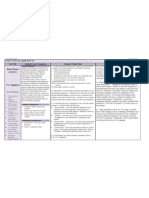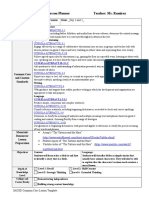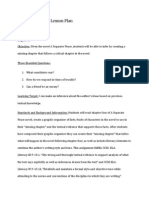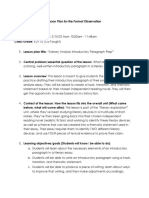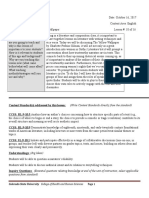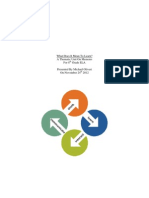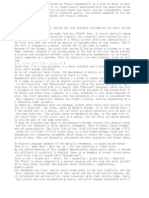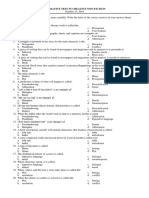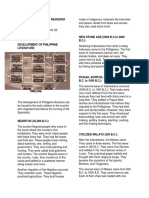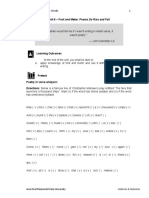Professional Documents
Culture Documents
TPCK Lee Petros
TPCK Lee Petros
Uploaded by
api-302439101Original Description:
Original Title
Copyright
Available Formats
Share this document
Did you find this document useful?
Is this content inappropriate?
Report this DocumentCopyright:
Available Formats
TPCK Lee Petros
TPCK Lee Petros
Uploaded by
api-302439101Copyright:
Available Formats
JPTAAR Lesson Format
Name: Petrros Lee
Grade Level: 10
Date lesson was taught: 9/15/15 9/24/15 Time: 1:30pm
Prior to Teaching
Justification
This section of the planning process helps you think through why this lesson is
necessary. It is the data that supports your purpose for the lesson. It contains the
following:
1) Pre-assessment:
One day I overheard a group of students talking amongst themselves
about their opinions of what we were doing in class, such as, Where are
teachers getting these interpretations from, I dont get this book, and When
will I ever use this. It is comments like these that led me to believe that my
students need to be shown how to appreciate works of literature not just as
stories, but meaningful commentary that reveals important values that can be
applied even today. Thus, I plan on walking them through the book To Kill a
Mockingbird, a classic work, which has blatant moral implications on the topics
of race, ethnicity, and cultureall of which are still significant issues today.
2) Purpose and relevance:
A students willingness to learntheir interior motivationis perhaps one of
the most important aspects to their ability in retaining the information of a lesson.
Students need to believe that what they are learning matters in a present-day
context and can be applied to their livesnot just within the classroom. This lesson
exploring To Kill a Mockingbird can be their stepping stone towards understanding
how to go beyond taking a story at face-value, but analyzing it through the use of
critical reading to find an overarching meaning.
3) Objectives:
After this lesson, students will be able to:
1.) Read critically and analyze other literary texts
2.) Synthesize current event articles with literary text (e.g.
Racial Issues)
4) Common Core Alignment:
This lesson fits in with common core standard thee, Aligned with
college and career expectations and four, Based on rigorous content and
the application of knowledge through higher-order thinking skills. In college
and careers, being able to read and think critically about what one has read
is not only important for English courses, but can be applied to other courses
that requires one to analyze information in a thought out manner. This lesson
will incorporate higher-order learning skills because reading with purpose is
not an easy task. Searching beneath the surface of the text in-class will help
students connect themes in literature with issues in todays world.
5) Technology Standards Alignment:
MTTS:
This lesson fits into standard 1. 1 states that students must access,
evaluate, process, and apply information efficiently and effectively. Because
students will need to find current events that correspond to the novels
themes, students will access databases and find articles to help them support
their main ideas in their essays.
ISTE-S:
This lesson fits in with standards 1B, 3B and 4a. 1B states that
students should create original works as a means of personal or group
expression. With any writing assignment, the idea and wording of the piece
should be original and from the mind of the own student.
3B states that students should locate, organize, analyze, evaluate,
synthesize, and ethically used information from a variety of sources and
media. With the lesson, students will be finding current event or scholarly
articles that show any sort of relational significance with To Kill a
Mockingbird. The article search will prompt them to locate and organize,
while students will have to evaluate and synthesize the contents of the article
into their writing.
4a states that students should be able to identify and define authentic
problems and significant questions for investigation. In the lesson, students
will have to identify the problems and issues that To Kill a Mockingbird
addresses and discuss those issues in their synthesis papers.
6) Post-Assessment:
Students learning will be assed based on a writing assignment they will
do. In class we will have had the chance to relate the values found in To Kill
a Mocking Bird with current event articles in an effort to reveal how
literature can be applicable to everyday life. Now, in order to see how much
the students have learned, they will be given the chance to do the same on
their ownwith a text of their own choosing.
Students will perform a close reading of their desired text and discuss
how its implications are relevant to the world today by providing a broader
meaning of the work.
Considerations for Teaching
7) Instructional Materials:
To Kill a Mockingbird Text
Computer
Example Article
Projector
8) Teacher Preparation and Resources:
To be knowledgeable about this lesson, I need to be familiar with the
novel To Kill a Mockingbird as well as how to approach literature in general
if I am to properly teach my students how to do close readings and analysis
of texts.
9) Media and Technology:
The technology used in this lesson would include computers, access to
the internet, and a projector. Using these technologies, I would teach kids how to
perform searches on databases to find scholarly and appropriate articles for their
research, show them example articles and example essays that I have written, and
perhaps show them the movie To kill a Mockingbird while we proceed through the
chapters.
10)
Differentiation:
For this lesson, if struggling students need help, I will pair them
with higher-achieving students so they can bounce ideas off of one another so they
are not overwhelmed by the individual writing assignment. In addition, I will also
post example essays about how to structure the writing assignment, as well as
provide a time when students can ask questions so I may guide them on how to
read and think critically about the text.
11)
Adaptations for students with special needs:
Special education students and/or students with IEPS will be given
accommodations or modifications for the lesson. In order to give them time
to think and contemplate about the topic more thoroughly, they may be
given extra time to write this assignment, or they may give a presentation
instead of writing a paper.
12)
Multicultural and Diverse Perspectives:
This lessons shows diversity because the wonderful thing about English
is that something in the text might mean one thing to a student while it may
mean another to another student. Likewise, what stands out to one student
may come off as completely irrelevant to another. Thus, this lesson shows
diversity through the different interpretations of To Kill a Mocking Bird that
the students have to offer. Specifically to To Kill a Mocking Bird, we will also
be discussing race relations during the 1960s.
13)
Possible Modification of Plans:
Finishes before due date: If the student finishes the assignment before the
due date, the student may submit their writing assignment to me and I will
edit their paper and hand it back with criticisms with what to do better--without a grade so that they may improve on their analysis.
Does not understand how to complete assignment: If students still do not
understand how to complete the assignment because they lack the skills
needed to perform a close reading and analysis of To Kill a Mocking Bird, I
will host a writing workshop in which I will assist struggling students at a
slower and perhaps more comprehensive pace.
During Teaching
Procedures:
14)
Introduction:
I will access the students prior knowledge by putting a short
story I made up myself and asking them to read it and summarize
it. Then, Ill ask them what the story means to them individually, to
gauge the amount of different responses I get in order to get a feel
of how good the students are at analyzing and coming up with their
own interpretations of any given text.
15)
Sequential Scaffolding Steps:
To start out, I will have a story on projected on the screen and I
will ask my students to read and then write down a summary of
what happened within it. I will then ask students to share what
they have written. Because I asked for a summary, Im
expecting many of them to be around the same, and I will guide
them to help them realize that this is only surface level reading,
much like one does for leisure.
16) Guided Practice:
To go into further depth, I will ask that the students tell me
what the story means to each of them individually, to get a feel of
whether they are able to develop their own interpretations of the story,
which is supported by the text. Then, I will ask the students to share
their interpretations. This will be the gateway into helping my students
learn how critical and close reading works. Throughout the course,
then, we will practice this through the novel To Kill a Mocking Bird,
only we will be exploring how the novel written in the 1960s is
relevant in a modern day context by going through the history of racial
tensions during the 1960s and then discussing how racial tensions
have or havent improved since then with scholarly articles and current
events.
17) Independent Practice:
At this point, I will ask the students to practice critical reading and
perform an analysis of several chapters. The students will be broken off into
several groups of my choosing and I will assign each of them several
chapters to analyze
Group 1- Ch.1-5
Group 2- Ch. 6-10
Group 3- Ch. 11-15
Group 4- Ch. 16-20
Group 5- Ch. 21-25
Group 6- Ch. 26-30
18) Closure
Each of the groups will present their close reading of their chapters
and we will have a discussion about how the textual evidence supports their
analysis and interpretations of the text. We will then discuss overarching themes
found within the given chapters and explore how these themes have a present-day
significance, hopefully displaying to the students that literature does indeed matter.
You might also like
- Mini Unit Plan Lesson 2Document7 pagesMini Unit Plan Lesson 2api-400748984No ratings yet
- A Quilt of A Country Unit PlanDocument6 pagesA Quilt of A Country Unit Planapi-242927781No ratings yet
- Differentiated LessonDocument3 pagesDifferentiated Lessonlindsay_115No ratings yet
- Early Narratives and The Epic of Gilgamesh Unit PlanDocument18 pagesEarly Narratives and The Epic of Gilgamesh Unit Planapi-299930429No ratings yet
- Lesson Plan Diverse LearnersDocument9 pagesLesson Plan Diverse Learnersapi-250420087100% (1)
- The Archetypes of Literature by Northrop Frye PDFDocument20 pagesThe Archetypes of Literature by Northrop Frye PDFalerh100% (4)
- Lesson Plan #1 1. Descriptive DataDocument16 pagesLesson Plan #1 1. Descriptive Dataapi-220232621No ratings yet
- Understanding by Design Unit TemplateDocument5 pagesUnderstanding by Design Unit Templateapi-318155534No ratings yet
- Writing Literary EssayDocument4 pagesWriting Literary Essayapi-654006591No ratings yet
- Lord of The Flies UnitDocument13 pagesLord of The Flies Unitapi-346585991No ratings yet
- Feature Lesson Plan RevisedDocument5 pagesFeature Lesson Plan Revisedapi-317142361No ratings yet
- Literacy Unit Plan CorrectionsDocument12 pagesLiteracy Unit Plan Correctionsapi-311313472No ratings yet
- Strategy Lesson 1Document5 pagesStrategy Lesson 1api-484708169No ratings yet
- Common Core Lesson3Document5 pagesCommon Core Lesson3api-400251601No ratings yet
- Grade 11 University English (ENG 3U) Unit Title Original Course Components Changes I Would Make Reasons For ChangeDocument5 pagesGrade 11 University English (ENG 3U) Unit Title Original Course Components Changes I Would Make Reasons For Changeapi-173928843No ratings yet
- Lesson Idea/Topic and Rational/Relevanc E: What Are You: CEP Lesson Plan FormDocument8 pagesLesson Idea/Topic and Rational/Relevanc E: What Are You: CEP Lesson Plan Formapi-353478397No ratings yet
- M Ryall - Itec 7400 El Final Draft Su2013Document4 pagesM Ryall - Itec 7400 El Final Draft Su2013api-259585577No ratings yet
- Interactive Read Aloud Lesson 2Document8 pagesInteractive Read Aloud Lesson 2api-399873247No ratings yet
- Les Article AnalysisDocument9 pagesLes Article Analysisapi-340985028No ratings yet
- Sunprairiesgrade 3 Unit 4 ResearchclubsDocument5 pagesSunprairiesgrade 3 Unit 4 Researchclubsapi-341428932No ratings yet
- Lesson Plan Day 3Document5 pagesLesson Plan Day 3api-317730714No ratings yet
- EistDocument4 pagesEistapi-662285236No ratings yet
- Existentialism Unit PlanDocument9 pagesExistentialism Unit Planapi-339056968No ratings yet
- Teacher: Desiree Iniestra Grade/Course: 4 Grade Title of The Unit of Study: LiteratureDocument6 pagesTeacher: Desiree Iniestra Grade/Course: 4 Grade Title of The Unit of Study: Literatureapi-614178391No ratings yet
- Unit Plan - Lesson Plan (Sample 1) : Your Name: Caitlin Hawkins Name of Unit: Heros/MoralityDocument10 pagesUnit Plan - Lesson Plan (Sample 1) : Your Name: Caitlin Hawkins Name of Unit: Heros/MoralityCaitlin HawkinsNo ratings yet
- PBL 5 e Model Lesson - Human AdvancementDocument22 pagesPBL 5 e Model Lesson - Human Advancementapi-234019859No ratings yet
- Action Research Lesson Week 2Document5 pagesAction Research Lesson Week 2api-510441034No ratings yet
- Jordan ConnorsDocument5 pagesJordan ConnorsohioseaprincipleNo ratings yet
- Schwartz Lauren Term IV Final Social Action Project 10-Day PlanDocument45 pagesSchwartz Lauren Term IV Final Social Action Project 10-Day Planapi-439822037No ratings yet
- The Outsiders Novel UnitDocument33 pagesThe Outsiders Novel Unitsgavan50% (4)
- Lesson Plan Day 1Document4 pagesLesson Plan Day 1api-317730714No ratings yet
- A Separate Peace Lesson PlanDocument4 pagesA Separate Peace Lesson PlanchelseapooleNo ratings yet
- 646 Short Story Keller-RevisionDocument17 pages646 Short Story Keller-RevisionJory ChristineNo ratings yet
- A Separate Peace Lesson PlanDocument4 pagesA Separate Peace Lesson Planapi-240767053No ratings yet
- Field-Experience-3 Lesson-Plan-Ela-Critique-WritingDocument7 pagesField-Experience-3 Lesson-Plan-Ela-Critique-Writingapi-368183330No ratings yet
- Formal Observation 2Document3 pagesFormal Observation 2api-662285236No ratings yet
- 5710lesson DesignDocument10 pages5710lesson Designapi-242108732No ratings yet
- Lesson Plan 5 Nonfiction Text Features - Clinical 429Document7 pagesLesson Plan 5 Nonfiction Text Features - Clinical 429api-176688637No ratings yet
- Wad Assignment - Phase 12and 3Document12 pagesWad Assignment - Phase 12and 3api-385087346No ratings yet
- Perspective of The Narrator, 10 Grade, English Materials NeededDocument3 pagesPerspective of The Narrator, 10 Grade, English Materials NeededchristophercanadaNo ratings yet
- Reading, 5th Grade, February 3rd 2016 Social Studies and Science: by Using Nonfiction News ArticlesDocument6 pagesReading, 5th Grade, February 3rd 2016 Social Studies and Science: by Using Nonfiction News Articlesapi-271086058No ratings yet
- CEP Lesson Plan Form: (Write Content Standards Directly From The Standard)Document8 pagesCEP Lesson Plan Form: (Write Content Standards Directly From The Standard)api-357419171No ratings yet
- English Lesson Plan 2Document4 pagesEnglish Lesson Plan 2api-518990010No ratings yet
- BarryunitplanfinalDocument7 pagesBarryunitplanfinalapi-551107380No ratings yet
- Teacher Candidate Lesson Planning Sheet Urban Institute of Teacher EducationDocument4 pagesTeacher Candidate Lesson Planning Sheet Urban Institute of Teacher Educationapi-341432415No ratings yet
- Educ463 Lesson 4Document4 pagesEduc463 Lesson 4api-550122992No ratings yet
- Genre Project Unit PlanDocument45 pagesGenre Project Unit Planapi-242273696No ratings yet
- Sarah King Lesson Plan R3Document4 pagesSarah King Lesson Plan R3Sarah KingNo ratings yet
- Itl 520 Learning MapDocument7 pagesItl 520 Learning Mapapi-535727969No ratings yet
- Bullis 09 HealthDocument16 pagesBullis 09 HealthAmit BhattacharyaNo ratings yet
- Krystinastump Edr628curriculumprojectDocument21 pagesKrystinastump Edr628curriculumprojectapi-285773334No ratings yet
- Multicultural Literature Lesson Plan 1Document4 pagesMulticultural Literature Lesson Plan 1Tammy DanielsNo ratings yet
- Michael Oliveri 341 Unit PlanDocument18 pagesMichael Oliveri 341 Unit Planmoliveri1No ratings yet
- CensorshipDocument32 pagesCensorshipElmer CrisostomoNo ratings yet
- 5-1-5FINAL CCSSO High School English - Short Stories PDFDocument9 pages5-1-5FINAL CCSSO High School English - Short Stories PDFDominic OntogNo ratings yet
- How To Motivate Your Students With A Book: The ProblemDocument4 pagesHow To Motivate Your Students With A Book: The Problembugoff700No ratings yet
- Lesson Plan 1 Creative StoryDocument6 pagesLesson Plan 1 Creative Storyapi-549228607No ratings yet
- Unit Plan Assignment 2Document13 pagesUnit Plan Assignment 2api-313149031No ratings yet
- E - Unit Fourth LessonDocument4 pagesE - Unit Fourth Lessonapi-436591204No ratings yet
- Noveling 101 UnitDocument22 pagesNoveling 101 Unit000767067No ratings yet
- Nonfiction Writing Strategies Using Content-Area Mentor TextsFrom EverandNonfiction Writing Strategies Using Content-Area Mentor TextsNo ratings yet
- ARMANDO CELAYO and DAVID SHOOK - Comics Adaptations of Ltierary ClassicsDocument2 pagesARMANDO CELAYO and DAVID SHOOK - Comics Adaptations of Ltierary ClassicsIrene BassiniNo ratings yet
- Too Loud A SolitudeDocument6 pagesToo Loud A SolitudeMordicusNo ratings yet
- Evolution of Indian English WritingDocument18 pagesEvolution of Indian English WritingFuzail KhanNo ratings yet
- Bahasa Melayu Sec 2022-23Document2 pagesBahasa Melayu Sec 2022-23exercisestartNo ratings yet
- Chinese LiteratureDocument15 pagesChinese LiteratureAdrian VelázquezNo ratings yet
- Joseph HellerDocument61 pagesJoseph HellerAminNo ratings yet
- Tanza National Trade School: Objective: This Aim To Describe The Learners Own Interpretation andDocument5 pagesTanza National Trade School: Objective: This Aim To Describe The Learners Own Interpretation andMaria Niña De GuzmanNo ratings yet
- BirchesDocument39 pagesBirchesabdulmusaver100% (1)
- Greek Christian Poetry in Classical Forms. The Codex of Visions From The Bodmer Papyrus and The Melding of Literary TraditionsDocument190 pagesGreek Christian Poetry in Classical Forms. The Codex of Visions From The Bodmer Papyrus and The Melding of Literary TraditionsMr. question100% (1)
- Knowing Women: Sei Shōnagon'S Makura No Sōshi in Early-Modern JapanDocument238 pagesKnowing Women: Sei Shōnagon'S Makura No Sōshi in Early-Modern JapanAna LuizaNo ratings yet
- David Lodge Man of PartsDocument3 pagesDavid Lodge Man of PartsAlexShearNo ratings yet
- 1the Wreck of The Hesperus and The HighwaymanDocument4 pages1the Wreck of The Hesperus and The HighwaymanjordanharperNo ratings yet
- An Introduction To The New Testament, Jülicher, Adolf. (1904)Document670 pagesAn Introduction To The New Testament, Jülicher, Adolf. (1904)David BaileyNo ratings yet
- Lesson - 1 LiteratureDocument7 pagesLesson - 1 LiteratureHeimi PatriarcaNo ratings yet
- Dactylic HexameterDocument5 pagesDactylic HexameterOanaMitracheNo ratings yet
- Creative Nonfiction Semi Summative PDF FreeDocument3 pagesCreative Nonfiction Semi Summative PDF FreeAlvin Somera SalarzonNo ratings yet
- Ela Grade 5 StandardsDocument6 pagesEla Grade 5 Standardsapi-366462849No ratings yet
- Mobile Assisted Language Learning - Review of LiteratureDocument36 pagesMobile Assisted Language Learning - Review of LiteratureJuan GarciaNo ratings yet
- Latin Elegy and Narratology Fragments of PDFDocument286 pagesLatin Elegy and Narratology Fragments of PDFteukerosNo ratings yet
- M1 M4 Philippine Literature ReviewerDocument23 pagesM1 M4 Philippine Literature ReviewerAndrea AbellanozaNo ratings yet
- Madame Bovary InfografikaDocument1 pageMadame Bovary InfografikaMagdalena AnsariNo ratings yet
- 52 Books 2020 Reading Challenge Suggestions SeptDocument21 pages52 Books 2020 Reading Challenge Suggestions SeptNatasha Chochkova100% (1)
- The Structural Analysis of "Take Pity" A Short Story by Bernard MalamudDocument6 pagesThe Structural Analysis of "Take Pity" A Short Story by Bernard MalamudCody TricksNo ratings yet
- Root Word Thesis ExamplesDocument5 pagesRoot Word Thesis Examplesafcnenabv100% (2)
- 7 T. S. Eliot and The Idea of Tradition: Gareth ReevesDocument1 page7 T. S. Eliot and The Idea of Tradition: Gareth ReevesparlateNo ratings yet
- Unit 6Document11 pagesUnit 6Justine CagatanNo ratings yet
- Secondary Education Curriculum Observation Sub-Cycle (Form 1, Form 2)Document88 pagesSecondary Education Curriculum Observation Sub-Cycle (Form 1, Form 2)Epie Frankline100% (1)
- Response Journal Grading RubricDocument1 pageResponse Journal Grading Rubricapi-208939839No ratings yet
- Complete The PoemDocument7 pagesComplete The PoemRichard VunNo ratings yet














